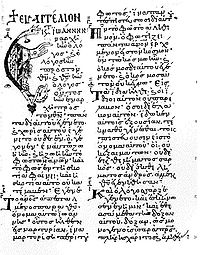Minuscule 348
| New Testament manuscript | |
 Folio 150 recto with text of John 1:1-14 | |
| Text | Gospels |
|---|---|
| Date | 1022 |
| Script | Greek |
| Now at | Biblioteca Ambrosiana |
| Cite | Scholz, Biblisch-kritische Reise (1823) |
| Size | 19.2 cm by 14.5 cm |
| Type | Byzantine text-type (not purely) |
| Category | none |
| Note | full marginalia |
Minuscule 348 (in the
Description
The codex contains a complete text of the four Gospels on 187 parchment leaves (19.2 cm by 14.5 cm). The text is written in two columns per page, in 30-31 lines per page.[2] The large initial letters are rubricated, the initial for epsilon has motif of the hand.
The text is divided according to the κεφαλαια (chapters), whose numbers are given at the margin, and their τιτλοι (titles of chapters) at the top of the pages. There is also a division according to the
It contains the Eusebian Canon tables, Argumentum, the
The texts of Matthew 16:2b–3, John 5:4, and John 7:53-8:11 are marked by an obelus.[3] Citations from the Old Testament are marked by an asterisk.[5]
Text
The Greek text of the codex is a representative of the
Textually it is close to the manuscripts 477 and 1279.
History

According to the colophon it was written in the year 1023 December 29. The colophon states: εγραφη συν θεω η βιβλος ταυτη των αγιων και αραπτων ευαγγελιων: ετους βφλα, ινδ εις τας ΚΘ δεκεμβριου μηνος η χειρ μεν η γραψασα σηπεται ταφω, γραφη δε μενει προς χρονους πληρεστατους.[8][9]
The manuscript was written in Calabria.[3] It once belonged to "J. V. Pinelli".[5]
The manuscript was examined by Scholz, who collated it in some places.[3] It was added to the list of New Testament manuscripts by Scholz (1794–1852).[10] Edward Maunde Thompson edited facsimile of one page the codex.[11]
The manuscript is currently housed at the Biblioteca Ambrosiana (B. 56 sup.) in Milan.[2]
See also
- List of New Testament minuscules
- Biblical manuscript
- Textual criticism
References
- ^ Gregory, Caspar René (1908). Die griechischen Handschriften des Neuen Testament. Leipzig: J. C. Hinrichs'sche Buchhandlung. p. 60.
- ^ ISBN 3-11-011986-2.
- ^ a b c d e f Gregory, Caspar René (1900). Textkritik des Neuen Testaments. Vol. 1. Leipzig: Hinrichs. p. 181.
- ^ Catalogus graecorum Bibliothecace Ambrosianae. Vol. I. Mediolani. 1906. p. 108.
{{cite book}}: CS1 maint: location missing publisher (link) - ^ a b Scrivener, Frederick Henry Ambrose; Edward Miller (1894). A Plain Introduction to the Criticism of the New Testament. Vol. 1 (4 ed.). London: George Bell & Sons. p. 232.
- ^ ISBN 0-8028-1918-4.
- ISBN 978-0-8028-4098-1.
- ^ J. M. A. Scholz, Biblisch-kritische Reise (Leipzig, 1823), p. 71
- ^ Catalogus graecorum Bibliothecace Ambrosianae. Vol. I. Mediolani: Impensis U. Hoepli. 1906. pp. 108–109.
- ^ Scrivener, Frederick Henry Ambrose; Edward Miller (1894). A Plain Introduction to the Criticism of the New Testament. Vol. 1 (4 ed.). London: George Bell & Sons. p. 225.
- ^ Edward Maunde Thompson (1912). An Introduction to Greek and Latin Paleography. Oxford. p. 238.
{{cite book}}: CS1 maint: location missing publisher (link) (plate 62)
Further reading
- J. M. A. Scholz, Biblisch-kritische Reise (Leipzig, 1823), pp. 70–73
- Edward Maunde Thompson, An Introduction to Greek and Latin Paleography (Oxford 1912), p. 238 (plate 62)
- Catalogus graecorum Bibliothecace Ambrosianae. Vol. I. Mediolani: Impensis U. Hoepli. 1906. pp. 108–109.
External links
- Minuscule 348 at the Encyclopedia of Textual Criticism
- Image
